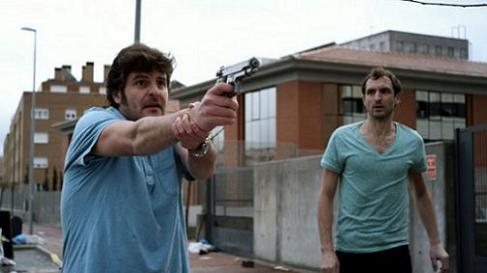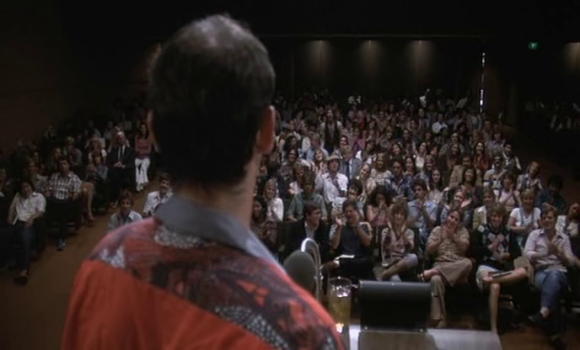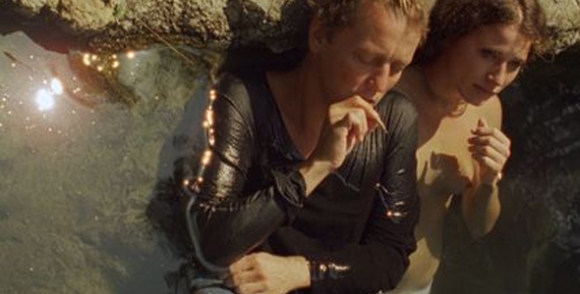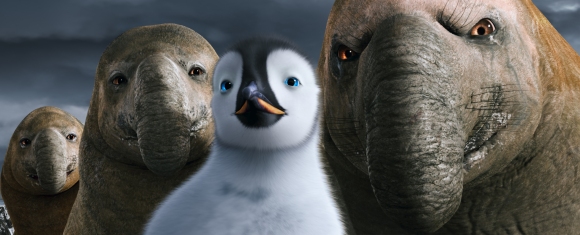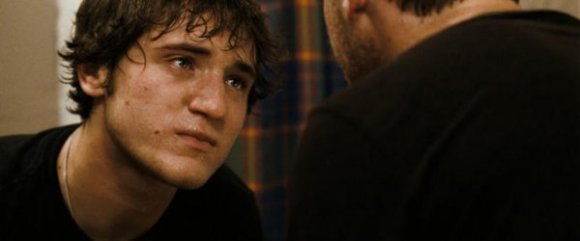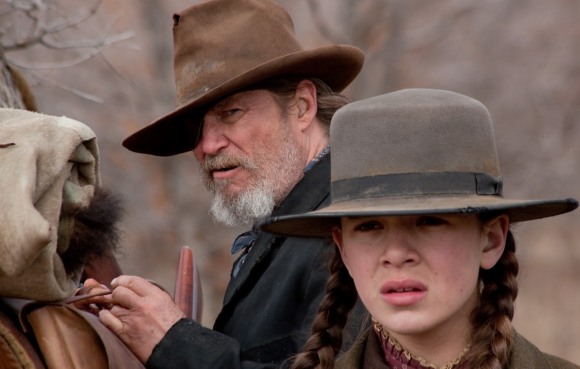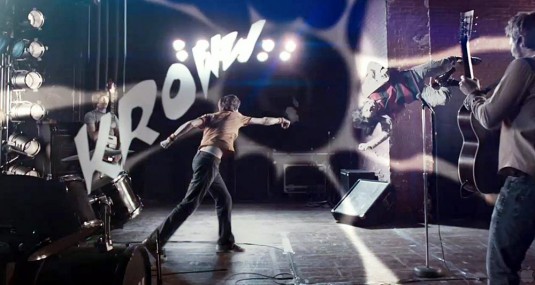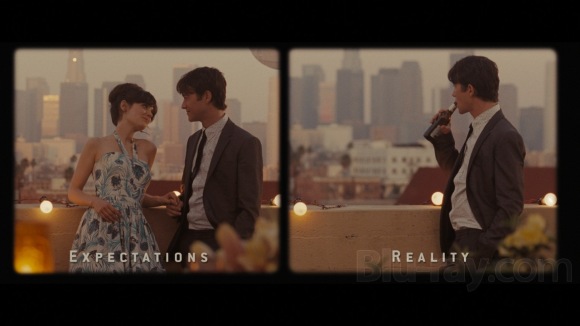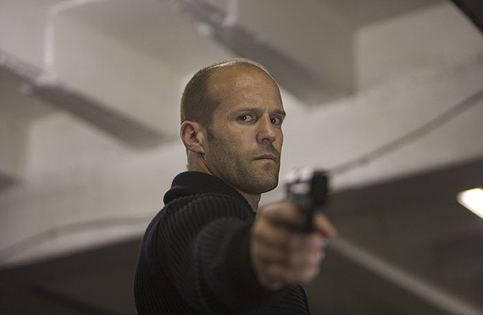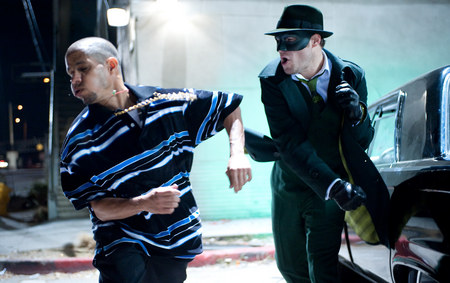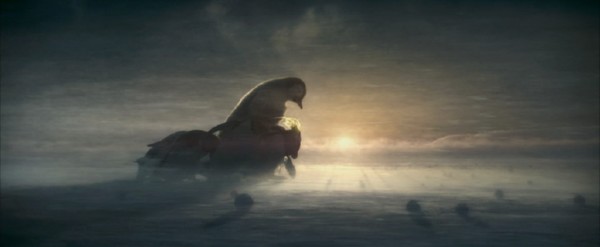Part two in my current series of essays – not written by myself, but instead presented initially by the clever Anon from 4chan’s /tv/. Intriguing – now, we’re moving on to Monster’s Inc and Finding Nemo, while A Bug’s Life is strangely absent. Oh, well.
MONSTERS, INC. (2001)

Monsters, Inc. came at an exciting time in the world of animation. In addition to Pixar making a play for alpha dog, Disney’s post-Katzenberg event flicks continued to do respectable business. DreamWorks was getting traction with critical successes like Chicken Run (if you have the stomach for cognitive dissonance, check out the Rotten Tomatoes page for Antz). Other studios were gearing up for the CGI scene. Animated features were conquering territory so fast that the 2001 Oscars added the Best Animated Feature category to keep them in their ghetto.
That was also the year of the first heavyweight Disney/DreamWorks throwdown, Monsters, Inc. versus Shrek. Everyone remembers Shrek as the clear winner, but was it? DreamWorks got the Oscar because Hollywood loves its own reflection, but Pixar grossed $50 million more and scored higher at RT. Perceptions are skewed by the subsequent Shrek franchise juggernaut, which exists partly because Mike Myers has a knack for persuading people he’s better than they know he is. (Seriously, nobody paid to see the first Austin Powers movie, but somehow he convinced the world they adored it and should flock to The Spy Who Shagged Me. He did the same with Shrek. The original was a big hit, sure, but a billion-dollar sequel? Shrek 2 was okay but come on. I smell sulfur and a signature in blood.)
With Monsters, Inc. Pixar played their own hot-celebrity card by hiring Billy Crystal as a sentient testicle. Crystal’s film career was in a mini-resurgence and he was a smash hosting the Oscar ceremonies throughout the 90’s, so his name definitely kicked up box office dust. Pixar’s mantra is to eschew celebrities and find the right person for a role, but they skated close to the line back then. When they cast Tom Hanks as Woody, he hadn’t yet gone nuclear with Forrest Gump but he was riding a string of big hits and some Best Actor hardware. Tim Allen had the #1 show on television. Of course Pixar famously offered Buzz Lightyear to Crystal first – apparently “the right person for the role” was a Jewish comedian from New York with a delivery somewhere between vaudeville and Woody Allen. (Imagine Buzz’s lines in Mike Wazowski’s voice. I prefer the cokehead from the Midwest, but the mind boggles at the possibility.)
I expect they would have hired somebody more popular for the role of Sully, but I’m pretty sure John Goodman had compromising photos of Michael Eisner at the time. So that was the Hollywood environment in which Pixar launched its counterattack against the DreamWorks ogre. What did they use for ammunition?
The premise for Monsters, Inc. is ridiculous. Let’s get that out of the way up front. Not so much the idea of a monster power plant that harvests children’s screams for fuel via transdimensional closet doors – that’s entirely deranged, for sure, but it’s a cartoon world. You allow a few insane precepts. However when the company can’t generate enough power to meet demand, we’re expected to believe the evil CEO responds by funding research on more efficient fuel collection? Don’t insult my intelligence. Low supply means higher prices. This was 2001, the era of Enron. It’s way more monstrous if Mr. Waternoose manipulates door selections to retard scream production, then enjoys a vigorous spree of price gouging, buys company stock with employee retirement funds and uses the profits to build a new ski lodge in Aspen.
Or should I say “Asp-en.” Like the snake, see? Because it’s scary? Okay, it’s a flimsy pun. Now tell me it wouldn’t be right at home in Monsters, Inc. The movie’s swimming in that kind of weak sauce. CGI flicks have always been terrible about that (DreamWorks even more than Pixar) because they write scripts around settings rather than characters or themes. There’s nowhere to hang a joke except some vaguely-defined backdrop. I call it okay-go humor. Imagine the writers gather in a conference room. Andrew Stanton turns to the others and says, “Brainstorm. A city populated by monsters. OKAY, GO!”
“Godzilla only has to take five steps to get to work!”
“Good! I’ll write that on the white board.” *squeakle squeakle squeakle*
“The Blob is there but he falls down a sidewalk grate!”
“Awesome!” *squeakle squeakle*
“And then he says ‘Oh, great!'”
*squeakle squeakle*
“The crossing sign says ‘Stalk/Don’t Stalk’!”
*squeakle squeakle squeakle*
Please God, strike me dead from flesh-eating nether-crabs if I have to endure any more of this. I don’t know what’s worse, the idea that they used every last stupid gag from their meetings, or that they actually threw out the dumbest ones. CGI movies are finally weaning themselves off this pap… just in time for the imaginatively-named Monsters, Inc. 2 next year. I wonder if it’ll be less homophobic than the original?
Come on, you had to know this was coming. The symbolism is so obvious, there’s no way it isn’t deliberate. Mike Wazowski could see it wearing an eyepatch and high-waisted pants.
Yes, my friends, let me tell you about the unnatural world of homo-sexuals. You can’t always recognize them around you, but there’s a place, oh yes, there’s a place where homo-sexuals run rampant just like they’re normal people. You’ll never see it if you’re lucky, and moral, and vigilant, but it’s there all the same. It’s the perverted world in the closet. All closets lead to this world. They’ve built an enormous closet door network, you see, because they’re frighteningly organized. Now don’t be fooled by their smarts. They’re cunning and insidious. In the closet world, though, it’s clear as day that they’re nothing but a horrible hidden city of grotesque monsters.
Of course they’re homo-sexuals, so it’s not a dark, bloody, scary world. This monster world is full of teal and lavender and fuschia and lime green. It’s all soft edges and warm light and colorful midcentury graphics. Even the monsters aren’t very scary, just freakish and generally disgusting. But that’s okay, homo-sexuals “love” all kinds. If you like “bears,” why, here comes James P. Sullivan, the biggest, cuddliest, belly-est furball you could want! Look, he’s walking with Mike, his one-eyed love goblin, out in plain sight for all the see. But’s that’s normal here. Everybody likes Mike.
Where’s Sully going? To work at the biggest facility in town! This is the industry that fuels everything here, the backbone of the closet world. And Sully is the most productive employee of them all. What does he do? Oh, he has a very important job for a monster. He spends his days preying on our unsuspecting children
But even Sully doesn’t know what the boss of the facility is planning. It’s the next step in the homo-sexual monster agenda, the one that will make all their dreams come true. They’re going to kidnap our children into the closet world. Yes, my friends, you must believe me. If nothing is done, this will happen! Let’s hope Sully realizes the error of his lifestyle! If we all pray real hard, maybe he’ll figure out that there’s only one thing he should do outside the closet world. One thing that any homo-sexual should do. Maybe he’ll get rid of his evil boss and make every employee in the facility join in! Then everyone in the monster world will understand that if a homo-sexual is out of the closet, all he’s good for is making people laugh. Homo-sexuals can be very funny. You have to admit that! I’ve seen them in several movies and television programs, like that one old boy on that game show. I’m sure you know who I mean.
Hey, there’s one now, performing a comedy routine. What’s he doing? Swallowing that phallic microphone?! Well heck, I suppose that is kind of funny, in a way! As long as he doesn’t do that in front of the children. He wouldn’t do that, now would he? But nahh, you’re right, that was a cheap shot. An easy gag. I don’t actually believe Pixar made a cartoonishly homophobic movie. Leave the Tinkertoy symbolism to DreamWorks. As we’ve seen, Lasseter’s boys are far more subtle and their misanthropy is infinitely more sophisticated. For Monsters, Inc. it all started with casting. We’ve already discussed Billy Crystal, but the telling roles are Sully and Randall. Quick, what other movie features both John Goodman and Steve Buscemi? Sure, you know this one: The Big Lebowski. Also Barton Fink, both Coen Brothers flicks. The Coens were hot snot in 1998, when Monsters, Inc. was getting off the ground. Fargo had collected a Hefty bag full of trophies and they followed up with their popular stoner-noir. Goodman and Buscemi shot five Coen movies apiece, and it was no accident that Pete Docter, the writer & director of MI, hired from their stable of regular actors. For his first movie, Docter plainly took his cues from the brothers. (Heck, he hails from Minnesota, which is just North Dakota with pro sports. Fargo definitely spoke his language.)
How did that influence Monsters, Inc.? You have no idea. The Coens are famous for their dark symbolism and penchant for Hitchcock/noirish motifs. Docter’s inspiration was to translate these ideas into the pastel-colored playground of a Disney family feature. He succeeded so well that audiences never realized they were watching the bleak downward spiral of a weak-willed man. His obfuscation put the Coens to shame, and that’s saying something. Even at the time, people often forgot how difficult it was to do “shaggy” with computer graphics. Pixar had top-of-the-line server farms, but they were still year 2000 machines. The other little effects shop George Lucas started, ILM, had patented a beautiful technique used in 1998’s Mighty Joe Young remake, but it was proprietary and Pixar had its own dungeon of programmers they could abuse to get the same result. Naturally they conquered the world.
The next time you watch Monsters, Inc. and marvel at scope of the climactic chase scene through the door warehouse, recall that you’re looking at thousands of rigid rectangular objects moving around common axes. That’s candy-corn kid stuff. Throughout the rest of the film, you’ve been watching Sully’s 2.3 million hairs flop around each other like well-ordered Silly String. The servers took 17 hours to render a single frame with Sully in it. Why go through so much trouble? Docter knew he had to sell you this character, and he threw as much computing power as he could at the task. It’s not happenstance that Sully is the only character in the whole movie you’d want to snuggle. You totally fell for it, too. (You can make arguments to include the disgraced Abominable Snowman in the snuggly category, as well as George Sanderson, the furry orange monster who not coincidentally is the only other scarer to instigate a “2319.” The purpose for these exceptions will become clear as we go.) The reason Sully is appealing is because the movie occurs in his POV. The entire setting and story are designed to characterize him via his naive, childlike worldview. So who is James P. Sullivan?
Sully is a company man. He’s the top performer in his entire office, about to break the all-time record even in a downturn. He lives in a colorful cityscape of warm weather and friendly neighbors and copious accolades at his job. The outrageous setting is the mental landscape, the “life of the mind,” of the real-world person he represents. But something’s wrong. To understand a character’s self-image, it’s revealing to examine what he considers to be alien. What constitutes “the other.” Sully lives in a city entirely populated by bizarre monsters of endless grotesque shapes and sizes. He’s the closest thing to a human being and the only one who’s soft instead of scaly or slimy or serpentine. Good grief, for Sully the entire world is “the other.” Our fuzzy protagonist is highly maladjusted. He’s alone in his mind.
So what about fast-talking Mike Wazowski, his roommate, coworker, sidekick and best pal? They’re joined at the hip because metaphorically, they’re two sides of the same character. Mike is Sully’s interface to the world. He’s the part that wants to be normal, to drive a car and have a girlfriend and live a real life. He’s Sully’s conscience – revealed in the very first shot of the characters – waking him up on time, making sure he’s in game shape. That’s why Docter made him a walking eyeball; he’s literally keeping an eye on Sully. Mike is Sully’s humanity. He’s a little green Jiminy Cricket. But he’s a Jiminy Cricket who actually succeeds in protecting Sully from the world. He’s Sully’s defense mechanism. Mike answers the phone after the TV commercial airs, keeps the janitors at bay when they praise him, romances Celia with cornball efficiency. But Mike’s as physically grotesque as the rest of the world, because Sully doesn’t understand social contact. Sully is detached, numb to actual human interaction. Witness his bored disregard of Celia. Assuming this romance represents an actual relationship in the real world, he’s clearly just going through the motions. Sully is an empty excuse for a man. Well, of course he is. He knows it. He’s a monster too. They didn’t name the character “Sully” to be cute.
There’s just one thing in the world that actually matters to Sully: his job. It’s all he really does. Mike chastises him for that. Mike’s well-adjusted enough to understand that the cute receptionist is important and the crap paperwork isn’t. Sully meanwhile just keeps working, without a thought or care. Practically the only other person he talks to is his boss, during which he’s revealed as a shameless suck-up. Man, no wonder Pete Docter had to make him fuzzy and huggable. The rest of him is just sad. In return the company itself, the titular Monsters Inc., takes great interest in Sully. But in what way? Do they appreciate the whole package? Let’s see, during the TV commercial they feature Sully twice, but when Mike appears they quickly blot him out. On the Employee of the Month wall, Mike is cropped out of every picture. Hell no, Monsters Inc. doesn’t want a Sully with a conscience and a life. They want a mindless performer, a number-producing robot.
So tell me, who is Sully without his Jiminy Cricket? He ain’t no real boy, that’s for sure. The Oscar-winning theme song spells it out as clear as you could ask: “I wouldn’t have nothin’ if I didn’t have you.” Sully is ultimately hollow without his little green mask. He’s a nonentity. A cog. Which begs the question, a cog in what? What exactly does Monsters Inc. do? I almost don’t want to say. You can bail now, if you want to preserve some remaining scrap of innocence. Unlike previous movies, I’m not going to spend much time on worldbuilding logic. Monsters, Inc. is so absurd that it’s basically logic-proof. Where the closet doors come from, how they sync up with their counterparts, how the monsters know about the children in their files, none of it was meant to hold up to scrutiny and it’s pointless to pretend otherwise. The “scaring children for fuel” gag is just a hook. The monster world is 100% allegorical. The important question is what it represents.
So what does the company Monsters Inc. represent? Let’s break down how it operates for Sully. His workplace is a huge, bustling facility that’s vitally important to the functioning of the city. No surprise there, he’s justifying his life of drudgery. Safe to say it’s not as glamorous in the real world. At the office, he and his fellow “scarers” are like star athletes. They get a slow-motion entrance and everyone ooo’s and ahh’s about how awesome they are. Again it’s justification, not to mention masturbatory. This guy’s got a major inferiority complex. What’s a scarer’s job? He receives a file about some unsuspecting person, goes in, frightens the piss out of them, collects the screams and starts over with the next file. The company matches him with the best victims. He may revisit someone he’s already scared, looking to spook more out of them. Sully in particular is an expert at squeezing out more screams than his coworkers. He tops the leaderboard. He is hot shit.
Wait, but what’s he really doing? What does “scaring” represent? Hmmm, screams are a pretty obvious analogue for money. He’s scaring money out of people. Is he an extortionist? No, holy crap, it’s worse – Sully is a freaking salesman. Probably hawking insurance supplements or fake security systems or something that requires scary stories about criminals or catastrophic health problems. Well, hell. Sully just got twice as pathetic as before, and that’s saying something. How about the closet doors, what are they? Instant connection to anywhere in the world, in and out quickly, making sale after sale after sale from one office. Jesus God, that sounds like a telephone. Yeah, it’s dawning on you now, isn’t it?
James P. Sullivan is a goddamn telemarketer.
The “scare floor” is a bloody call center. Sully is top dog in a crowded, dimly-lit boiler room, preying on weak, innocent victims rendered as children but more likely to be senior citizens. Think of that the next time you watch all those cannisters filling up. Blllllloop! Another old grandmother robbed of her retirement. Blllllloop! And another one. Bllloop bllloop bllloop bllloop! Slumber party! I suppose it’s no wonder Sully thrives here. He’s disconnected from society. When he goes in for a sale, he doesn’t even bring his conscience. Nor has he any chance of developing something like a real human identity; the horror of being a predatory monster will push any spark of humanity to a safe distance. Meanwhile Mike, in his role as defense mechanism, keeps the world at bay, happily calls this life “success” and dreams of his car and his date with Celia.
Pete Docter, you magnificent asshole, you used millions of dollars of technology to make us root for this despicable son of a bitch. And that’s just the movie’s setup. Which brings us to the actual plot of the film, wherein a monster falls in love with a human little girl. Does the real-world bully – I mean “Sully” – encounter a victim of his telephone terrorism? Does the monster meet his match? Come on, this isn’t Beauty and the Beast or its rote inversion, Shrek. Docter is no Katzenberg. As you can imagine from the setup, he’s after something much more twisted and dark.
“Nothing is more toxic than a human child.” Hasn’t that always seemed like an odd claim? Monster society keeps a whole branch of agents on standby to handle the danger of toxic children, yet children aren’t toxic, something Waternoose, Randall and even Roz already know. The cartoony setting of Monsters, Inc. isn’t supposed to make sense, but this was always a weirdly obvious stumble given its major role in the motivation of pretty much every character. I don’t know if Docter and his team didn’t sufficiently spackle the plot hole, but its presence is revealing. The only conclusion is that “children are toxic” is a myth designed to warn monsters away from interacting with kids. Fill in your own perverse theory about why; it doesn’t matter. We’ve already established that children are metaphorical in this movie. Let’s follow the path that Docter laid out and see what answer it leads to. Sully works the phones in a sleazy boiler room. He’s the biggest producer, but he has a sneaky, belligerent coworker named Randall who does everything he can to take the top spot. One day Sully – conspicuously without his Jiminy Cricket – finds Randall working after hours on some secret scheme, some edge to get ahead. Naively, he pokes his nose where it wasn’t invited.
Then something happens. In the movie it’s the arrival of Boo, a two-year-old Asian-American girl (presumably she’s American, though the time zone board had stopped over central Asia). Sully’s horrified! He runs around like a madman but there’s no escape, so he takes her home. The authorities are on alert! This could wreck his job! Mike’s more worried she could kill them. They need to get rid of her immediately. Then Sully finds a quiet moment and starts to think hey, you know, Boo’s not really so bad. Maybe they can take her to work tomorrow and fix it there. Mike protests, but Mike’s not in charge. The office is swarming with agents, but they can’t turn back now. Mike is determined to send Boo packing. First he summons a random door, but Sully balks. He’s starting to like Boo and won’t get rid of her that way. Then Boo vanishes and Sully is utterly panicked until he finds her again. Mike finally gets the correct door from Randall, and Sully balks again. You can’t trust Randall! Holy cow, Sully always has an excuse not to let Boo go, doesn’t he? It’s like the more he’s with her, the more he wants to stay with her. Even at the risk of ruining his career, or possibly his life. Everyone else sees Boo as dangerous, but to Sully she’s a sweet, innocent, mischievous little secret that comforts him like nothing else can. For the first time in his empty life, he can feel something.
So what does Boo represent? Have you pieced it together yet? For the answer, I refer you to The Diagnostic and Statistical Manual of Mental Disorders, Fourth Edition. The DSM-IV gives seven criteria to diagnose substance dependence: “unsuccessful efforts to cut down or control substance use”, “important social, occupational, or recreational activities are given up or reduced” and so on. The next time you watch Monsters, Inc., see if you can check each one off the list. After the end of the first act, when Boo appears, they fall like British Petroleum stock. The evidence is all there in soothing pastels. Sully, the near-sociopathic phone-shark, stumbles across something that suddenly makes him feel emotion. Something that seems human in his world of monsters. Something that society warns you is poisonous and enforcement agents are always chasing. Seriously, the question isn’t whether Boo represents an illicit drug, but which one? Pete Docter named her after an old term for pot, but that doesn’t map. (Hey, Dory’s not a dory and Marlin’s not a marlin.) The whole thing started with Randall looking for an extra edge in the boiler room, so most likely we’re talking about some species of amphetamine. Regardless, Sully stuck his hand in the cookie jar and got the cutest little monkey on his back. (That shot always gets a hearty laugh, doesn’t it?)
With that piece on the table, it’s easy to fit the whole puzzle together. While you read this, think as Pete Docter did when he wrote it: this is a Coen Brothers movie starring a bewildered John Goodman and a scummy Steve Buscemi. Everyone’s in over their head and the only good guy is the creepy lady cop working undercover as the bookkeeper. Business is down, so call center kingpin Mr. Waternoose has started dealing on the side, using Randall’s aid and connections. Sully bumbles into the plot and, out of his mind on the product, nearly hands the whole thing over to the feds. Waternoose fires him, leaving him out in the cold, but didn’t count on Sully’s newfound meaning in life. Sully returns, steals a fix from Randall and trips like hell while fighting off the scumbag. After a chase sequence, Randall falls into the hands of one of their telephone victims, who beats him to death with a shovel. Meanwhile Waternoose is trying to hand Sully to the feds as a fall guy. How does Sully win? He tricks the old man with a magic closet door – which is to say, a telephone. He gets Waternoose to confess and records it for the cops. Sully is, after all, the top phone-shark in the company.
That’s the superficial plot, but the real story is in Sully’s head, where the truly twisted stuff happens. That’s what Docter put on the screen and called a family movie. Let’s have a look at the black heart of Monsters, Inc., then wrap it up and move on. I’m starting to get depressed just reviewing it. To track Sully’s heartwarming downward spiral, we only have to observe his relationship with Mike, his conscience and connection to society. When Sully grows fond of Boo, Mike screams at him to come to his senses. Sully knows he’s doing something wrong. Then they get tossed out in the cold and Mike’s had it. He draws the line. But it’s too late – Sully’s cut off from his Boo and she’s important enough to sacrifice everything, even the career that once gave him purpose. Nothing else matters. So he turns his back on his conscience. Fuck reality. You’d think this is the low point for Sully, but you’d be wrong. Because this is where his abused conscience start to crumble. Mike chases after him and starts making excuses about how he was confused and needed time to think. The last vestige of Sully’s willpower is failing. His only link to reality is corrupted. From here on, Mike literally humors Boo. (Nice touch, Docter.) He’s even misty-eyed after Waternoose is arrested and the authorities force Sully to give her up.
The end is the darkest scene of all. Robbed of his newfound emotional awakening, Sully has returned to what he knows – his work. He’s taken over running the boiler room. Of course under his watch everything’s happy clowns and juggling balls. His low self-esteem has re-emerged, so he fantasizes himself a big shot again. He’s even on the cover of a magazine. (The magazine is named “Business Shriek!” *squeakle squeakle*) But it’s worse than before. Now he understands how empty he is. It’s his corrupted conscience, scarred and bandaged, that finally comes to the rescue: Mike leads him back to the loving embrace of Boo, the beautiful miracle that makes him warm and innocent. Every part of him now believes this is right and good. Sully takes the final step into ruinous addiction at the sweet little voice that cries “Kitty!”
Brrrr. You know, when I first saw this movie, I wondered why Waternoose got arrested for planning to kidnap children. Are the monsters suddenly sympathetic to their prey? Then I realized they didn’t care about the kids – they cared that he was endangering the monster world with hazardous contraband. Pete Docter had totally suckered me with the adorable Boo and fuzzy ol’ Sully, so much that I lost sight of the premise. That’s the genius of Monsters, Inc. It’s the story of an emotionless scumbag whose desire to feel good drags him all the way down, and he goddamn deserves it. Pixar ran it through their dream machines and cutting-edge computers and made us feel as euphoric as Sully when he’s stoned. They’re the masters of euphoria, right? Don’t they always make us feel warm and innocent?
Suckers.
Yes. Also, surprise – Finding Nemo.
FINDING NEMO (2003)

If Toy Story launched Pixar and Toy Story 2 boosted them into high orbit, Finding Nemo kicked them into warp drive straight at the fucking face of God. The captain of the Starship Hubris was Andrew Stanton. Stanton was a writer for all the previous movies and lead name on the last three, but this was his first time in the director’s chair (an Aeron, no question). Looking at the assignment, I’m pretty sure John Lasseter was hazing the rookie. The degree of difficulty in this film is positively unwholesome. To start with, it’s a movie about fish. Think about that. Any animator can make toys, bugs and monsters dance and sing. But a fish is just a floating face. It’s as if Lasseter took Stanton’s characters, yanked off their arms and legs and handed them back. “Still think you can win an Oscar, Andy?”
On top of that, most of it takes place in the open ocean. Remember in the previous films, all those countless clever details and jokes and Easter eggs in the background? Forget that sissy bar, Poindexter. A good third of this movie has no background at all. Much of the rest occurs on a dull, featureless sea floor. Finding Nemo makes Our Town look like freaking Phantom of the Opera. Plus we shouldn’t have any villains like before. Villains are a crutch, am I right? And just for fun, let’s kill four hundred children in the first five minutes. OKAY, GO!
This movie is an impossible task. This is sixty men guarding Humperdinck’s gate. This is Han Solo facing three Star Destroyers. It’s like a circus act that piles on more obstacles, just to be insane. “Ladies and gentlemen, please direct your attention above the center ring, where Pixar will now attempt to produce a hit movie… about faces floating in a void! Not difficult enough, you say? What if they have to do it… with Albert Brooks and Ellen DeGeneres in the lead roles!” What sort of arrogant bastards take a kid’s movie and turn it into an epic ego-gasmic grandstand? They couldn’t have been more ostentatious if they’d dressed like Evel Knievel and driven a Bugatti on the wing of a stealth bomber. Finding Nemo made it official: Pixar is the ‘roid-stuffed bodybuilder in the gym, and you can’t use the freeweights until he’s through posing in the mirror. Just watch and dream, flab-butt.
Incidently, I wasn’t serious about Lasseter assigning Andrew Stanton the movie. Finding Nemo was Stanton’s baby, script to screen. He got an Oscar nom for the screenplay and rightly so. It’s crazy dense with craft. The humor is character-driven, with minimal capitulation to punchlines and broad absurdity and okay-go stuff. Above all it’s sober and deliberate. No thin spackling here. (Well, maybe one spot.) So it can’t be an accident that, for a colorful film about talking fish, there’s an awful lot of death imagery. Not just the manipulative mass-child-murder opening (“Oh look, they’re dreaming!”) or the endless parade of deadly threats. I mean random bits, like Gill living in a skull and the recurring abyss scenes and “Conscience, am I dead?” This movie has death written all over it. Look close and you’ll find that it’s intrinsic to the whole structure of the film. I should probably explain what that means.
You may or may not know that modern Hollywood movies are all about structure. And by “structure” I mean “shameless formula.” In 1979 the screenwriting guru Syd Field turned Aristotle’s three-act format into a Tinsel Town religion called the Paradigm (yes, capitalized). Here’s the gist: A movie is divided into four quarters. The first quarter is the first act, the setup. Near its end commences the first big turning point, where the story takes off. Usually this occurs fifteen minutes in. (Go ahead, load up your favorite Hollywood flick. Fast forward to the fifteen-minute mark. It’s the first turning point, right? Early Pixar was slavish to this timestamp.) The next two quarters of the film comprise the second act, what Syd Field labels “Conflict,” in the middle of which occurs a “point of no return.” The end of act two is the second major turning point. The last quarter is the climax and denouement. Roll credits. (If you want to depress yourself, think of any wide-release movie from the last thirty years. Now watch how it bows to the formula like a perverse Lovecraftian god.)
Finding Nemo follows the Paradigm. Divide up the running time and check the timestamps. It’s pretty spot-on. Stanton obviously kept a firm hand on the structure of the screenplay. So why does it seem like so much more happens in Nemo than in other movies? And what does that have to do with death imagery? The why is structural. Nemo is built like a cathedral, with stunning art layered atop precise architecture. As for the what, have you ever seen All That Jazz? The movie All That Jazz has a recurring motif about the “five stages of grief” (where “recurring” means “drilled into your head like trepanation”). The five stages describe emotions felt by someone who is dying or grieving a loved one. In Finding Nemo, death-obsessed Andrew Stanton uses them as a second layer of structure. (The primary layer, as we discussed, is Syd Field’s Paradigm. Despite Pixar’s idyllic workplace, so famously isolated from Hollywood, the Paradigm lives like a cockroach among the lunch counters manned by cherub orgies and computer chairs stuffed with unicorn eyelashes.) As repeated ad infinitum in All That Jazz, the stages are Anger, Denial, Bargaining, Depression and Acceptance. Split Nemo into five parts and you’ll find they track within a minute.
– The first stage, Anger, pivots around Nemo and Marlin getting angry at each other, triggering the whole adventure.
– The second stage, Denial, kicks off with the fish-addict sharks. The theme is right in the dialogue: ” I don’t have a problem.” “Oh, okay. DENIAL!”
– The Bargaining stage is about Gill’s scheme to escape the dentist’s aquarium, while Marlin negotiates with Dory and a school of real asshole performance artists.
– Depression starts with Nemo and Gill moping over their failure. This is the segment where Marlin and Dory are stuck inside the whale, Joseph Campbell’s symbol of the death and recreation of self.
– Acceptance begins when Nemo gets scooped out of the tank, to be given to Darla. Marlin arrives after his long journey to find that Nemo is dead. He heads for home while Nemo literally goes down the drain.
Okay, but what’s the point? Why did Stanton build his script around grief? Because Finding Nemo isn’t a movie about a child growing up. It’s about a child never growing up. Once again let’s dive into the subtext to see what’s bubbling under the surface. (No, I have no shame. Why do you ask?)
Finding Nemo starts with a very different Marlin. He’s noticably cavalier toward the four hundred eggs he and his mate are about to hatch. “We’ll name this half Marlin Junior and this half Coral Junior. Okay, we’re done.” He’s much more interested in flapping Coral’s flippers. He’s also cocky and confident. When the barracuda attacks, the tiny clownfish charges right into battle. This little dude has grit. Then Coral and the embryos are devoured and a single egg remains: Nemo’s. Not much subtext is hidden here; it’s all on the surface. Our protagonist’s family dies. The only question mark is the surviving egg. Now we skip ahead to Nemo’s first day of school. This symbolism is pretty blatant – we’re dealing with separation anxiety. After the opening tragedy, Marlin is neurotically skittish. His grit is apparently destroyed. When Mr. Ray swoops in and takes the boy away, Marlin freaks out, chases them down and refuses to let Nemo go. This action kicks off the whole adventure.
What does this sequence represent? It isn’t difficult to work out. Nemo started production just after The Sixth Sense grabbed 1999 by the short hairs. Secretly-dead stories were popping up like barnacles on a corpse. Andrew Stanton wasn’t immune to its gimmicky charms. It’s a parable within a parable. Look closer: the barracuda scene ends with Marlin finding a lone, improbable survivor. What’s he feeling at that moment? His future is destroyed and this little orange egg is the last scrap for a scrappy fish to hang on to. Remember, Marlin’s a fighter. He’s not going to let this egg die. We cross-fade into the titles, then segue without a cut into Nemo as a child. We’ve now passed into the future that Marlin, in his mind, is protecting. What seems like cowardice is actually Marlin fighting desperately not to let go of the last egg. He hasn’t lost his grit at all. He’s redirected it against a horrible, empty future. Stanton has thrown us a clever, if rather morbid reversal.
From there the metaphor is clean and clear. Mr. Ray takes Nemo to the place where Coral and the other eggs became sashimi. Mr. Ray is the grim reaper, a psychopomp stealing away his son. When Marlin interferes, Nemo gets whisked off by a godlike diver. Nemo’s now stranded in a cramped glass limbo, separated from the world of the living but unable to pass on. Unwilling to accept his son’s death, Marlin has metaphorically trapped the boy. The movie then chronicles the steps of his grief until at last, in the dentist’s office, he sees Nemo floating belly-up and finally accepts the truth. Nemo, the metaphor for the last egg, is dead. Only after this happens does Nemo escape limbo, passing through the proverbial tunnel to oblivion. Dory, the avatar for Marlin’s memory as he tries to forget the tragedy, allows him one last glimpse of his lost boy. This is when he’s waking from his metaphorical journey (“Swim down! Swim down!”). As Nemo lies unmoving on the sea floor, the story flashes back to the present, where Marlin is holding the last egg. We’ve come full circle. Marlin now accepts the death of his family and his future. The movie closes as Marlin’s grit fails and he allows death, as Mr. Ray, to take Nemo away for good. Somewhere in the present, Marlin drops the dead little egg and swims away into the night.
The ending always made me tear up, but I never knew exactly why. The fact is, Stanton has given us the saddest goddamn movie ever to pretend it’s a lush, colorful exploration of parental love. You wonder why I show him respect? The macabre motherfucker earned it. Stanton doesn’t limit his structure to Dr. Kubler-Ross-with-a-dash, by the way. For the sake of brevity I won’t go into great detail, but pretentiously enough he also leans on Dante Alighieri’s Divine Comedy. Dante’s Purgatorio is a place where souls must atone for the Seven Deadly Sins before reaching Paradise. To demonstrate how Stanton (who is vocally religious, like most Pixar brass) references this, let’s examine the first Deadly Sin he tackles: Lust. In Dante’s tale, Purgatory for the lustful is a mountain ledge with a precipice on one side and a wall of fire on the other. Sound familiar? In the opening scene of Nemo, Marlin and Coral move into a stinging anemone – portrayed like a living flame – at the Dropoff. When they start getting frisky, the barracuda appears. At stake are hundreds of eggs, the product of their Lust. We know how it works out.
Coincidence? Sit tight. You know how Nemo’s fish tank is a reflection of his prior life? Now recall his initiation when he swims up the side of Mount Wannahockaloogie, which is covered with orange pebbles notably similar to clownfish eggs. At the top, he must pass like a penitent through the “Ring of Fire.” (Oh, that’s why they called it fire.) Yeah, there’s no question this imagery is deliberate. Nemo and the aquarium inmates work through each Deadly Sin just as Marlin does. I’ll leave the other sins as a homework exercise. (Gluttony comes next. Dante had a specific order.) The point here is that Finding Nemo isn’t just a sad, bittersweet tale of a father letting go of his son. Nemo has an undercurrent of dark self-righteousness that belies its visual innocence. For example, why did Coral and the babies deserve to die? Simple: fornication. You always assumed Coral was Marlin’s wife, but strangely, words like “wife” or “husband” or “married” never appear in the film. Do these talking beasts even wed? Or do they just breed, like Hollywood movie stars? The barracuda is a pretty big tell from Stanton.
How about the movie’s opinion on addiction? There’s a scene about sharks who decide to stop eating fish via an AA-style program of steps. (Allegedly they just eat dolphins.) It’s a gag when two of the three fail onscreen, but the real offense is that sharks are designed to eat fish. It’s intrinsic to their nature. These addicts are destined to fail; moreover they were destined to become addicts from birth. What is Stanton saying about addiction here? And are sharks racially inclined to be degenerate? His Christian charity seems to yield to something very ugly. And the ugliness keeps coming. We’ve talked about Pixar’s treatment of female characters. This movie is particularly grim. We’ve got a fornicator, a brain-damaged simpleton, a narcissist schizophrenic, an idiot pet-killer and a starfish who’s basically the aquarium secretary. Even the octopus girl poops herself. Meanwhile the dudes are smart and capable and resourceful. How did we get here, Pixar? You always say you make the kind of movies you like to watch. Your message is loud and clear.
